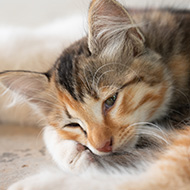
The RVC has published two studies investigating the cause of the 2021 fatalities.
UK vets have revealed new insights into the 2021 outbreak of feline pancytopenia.
The rare condition sparked concern amongst cat owners and garnered significant media attention at the time, owing to a rapid increase of cases.
Researchers say their findings suggest a link between high concentrations of trichothecene T-2/HT-2 mycotoxins - poisonous substances, produced by fungi – in many of the food samples from recalled batches of cat food.
The amounts were much greater than recommended by the European Comission, the team writes in the Journal of Veterinary Internal Medicine.
Led by the RVC, the research describes 580 cats recorded by the College during the initial outbreak, the epidemiology of the cases, and the link with mycotoxin exposure, which can be severely damaging or even fatal to cats.
White blood cells and platelets were severely depleted in the cats when they were first diagnosed. An analysis of the data for these cats revealed three diets that most of the afflicted cats had consumed, which ultimately led to a UK-wide recall in June 2021.
Further analysis of the feed samples and the discovery of mycotoxin contamination, which is known to be toxic to bone marrow, led the team to conclude that this should be considered as the cause of the outbreak.
A second study, also by the RVC, examined 50 cats diagnosed with pancytopenia to identify additional clinical signs suggesting contact with mycotoxins.
Analysis of the cats' bone marrow found that all cats suffered a marked toxic insult. The team concludes that a differential diagnosis of mycotoxin-induced pancytopenia should be considered in cats presenting with pancytopenia.
Lead authors Dr Barbara Glanemann and Dr Karen Humm, said: “These pieces of research involved a great deal of work from many people and we really appreciate the teamwork involved, and the collaborative support we received.
“We know first-hand how much devastation and concern this outbreak caused for many cat owners across the country and so it is our hope that the studies will help people better understand what happened to cause this outbreak and can be used to not only provide some closure to those affected but also reduce the chances of something similar occurring in the future.”



 The RCVS has announced a new version of its 1CPD mobile app, with enhanced features for veterinary surgeons and veterinary nurses to record their continuing professional development.
The RCVS has announced a new version of its 1CPD mobile app, with enhanced features for veterinary surgeons and veterinary nurses to record their continuing professional development.